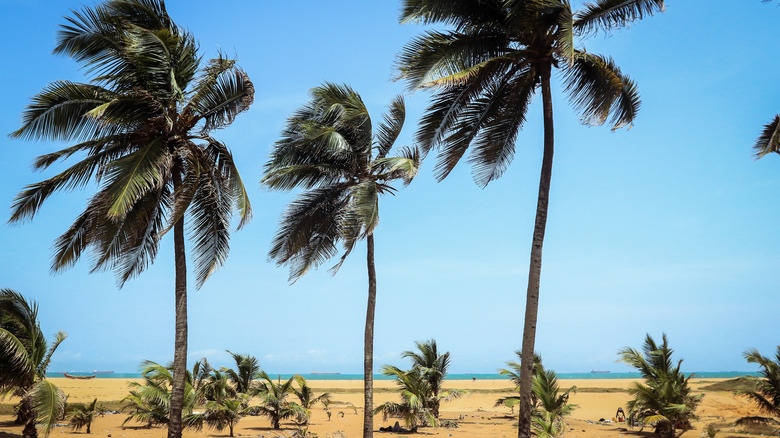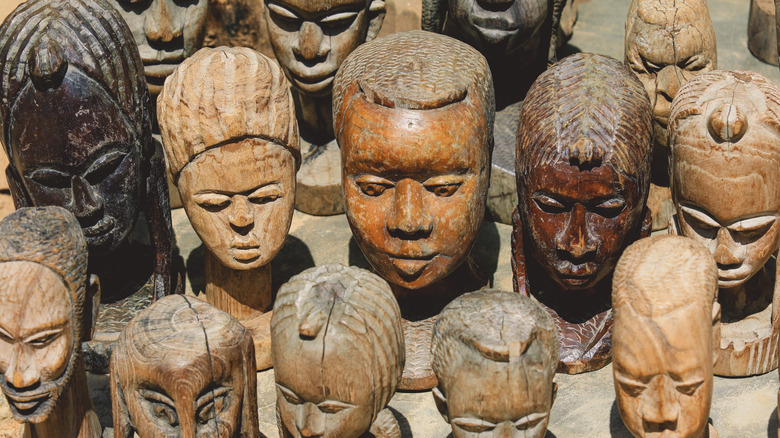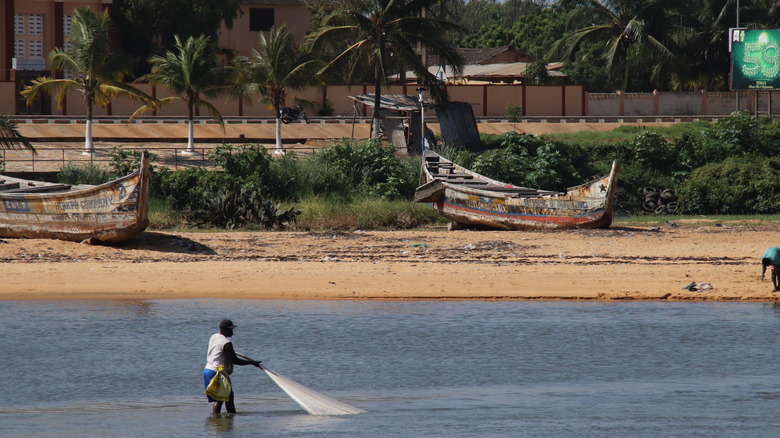West Africa's Hidden Gem Country Has Golden Tropical Beaches, Abundant Wildlife, And A Bustling Voodoo Market
When you think of the most famous beaches around the world, hot spots like Bondi Beach in Australia or Copacabana in Brazil might come to mind. Maybe you picture the shimmering white sand and turquoise waters of the best beaches in the Caribbean. Chances are you probably don't think of Togo, a small, vertically shaped country about the size of West Virginia, nestled in the center of West Africa. Tucked between Ghana and Benin, with Burkina Faso to the north, and a 35-mile coastline along the Gulf of Guinea as its southern border, Togo is a hidden gem, offering an uncommercialized glimpse of West African life with natural beauty, vibrant culture, and tranquil beaches.
Officially the Togolese Republic, Togo is one of Africa's smallest countries. Its capital, Lomé, sits near the Ghanaian border, right on the coast, and is home to one of West Africa's deepest ports. Lomé-Tokoin International Airport (LFW) is the country's main airport, with many intercontinental travelers connecting through Washington, D.C., New York, Paris, Brussels, or Nairobi. The best time of year to visit Togo is during the dry season, November through March. Sunny, dry days and lower humidity during this time are conducive to outdoor activities, though the overall tropical climate can be unpredictable.
Togo's beautiful shoreline also has a painful legacy. The country was once part of the "slave coast," which included Benin and Nigeria. During the late 1700s, Denmark controlled trade along Togo's coast, and by the mid-1800s, Germans had colonized it, building railroads, shipping docks, and other infrastructure. After World War I, Togo was ceded to the French until the country gained independence in 1960. Today, French remains the official language, though two African languages — Ewé and Kabiyé — are also widely spoken.
Visiting Togo's more stable southern region
Since Togo is an underrated destination for many Western travelers, it may seem like an unknown, prompting the age-old question: Is it safe to travel? Togo is a level 2 travel risk per the U.S. State Department — meaning exercise increased caution due to crime, primarily at night in isolated areas. As of this writing, the U.S. advises travelers to avoid Togo's northern borders with Burkina Faso and Benin, occupied by extremist groups. To put that into perspective, however, both Italy and France are also considered level 2 travel risks: Italy for possible terrorist violence and France for possible terrorism, as well as petty crime.
However, if you want to stick to the country's more stable southern regions, the country's capital, Lomé, is an excellent place to start. Take in the local spices, mass-produced goods, bright textiles, and handicrafts at Lomé's Grand Marché (Big Market). This loud and colorful maze-like market is a good place to shop and chat with locals. A mile northwest of the Grand Marché, the Independence Monument stands as a reminder of Togo's independence from French colonial rule and a dramatic backdrop for photos. The surrounding neighborhood offers several international restaurants, as well as one of the only rooftop bars in the city.
For something truly unique, visit the Akodessawa Fetish Market, one of the largest voodoo markets in West Africa. Here, you'll find animal skulls and hides, raffia dolls, carvings, herbs, and other materials used in traditional African medicine and voodoo practices. An admission fee is under $6 as of this writing, and visitors recommend going in with curiosity and an open mind. Also check out Artisan Village, a quieter, more handicraft-focused market, for goods like art, masks, carvings, and batiks (Africa's signature colorful fabrics made by wax-resistant dyeing). You can also visit the Togo National Museum to learn more about West Africa's diverse Indigenous people and colonial history.
Togo's beaches, cultural landmarks, and beautiful natural areas
West Africa is known for its cool-vibe beaches with fresh seafood, music, and swaying coconut trees, and Togo has some of the finest. Some are lively, lined with resorts or shack-style bars and eateries, while others are secluded and more suitable for swimming. New Robinson Plage is a tranquil spot where it's safe to swim during low tide. Straw-thatched beachfront bungalows line the shore, and small eateries provide opportunities to indulge in grilled fish, djenkoumé (cornmeal cakes), and light beer, like local brews from Brasserie BB Lomè. Blue Turtle Bay offers a resort-like experience with a hotel, restaurants, and protected areas for nesting sea turtles. You can swim or kayak in the sparkling water, and when you're ready to rest, luxuriate in beachfront bungalows. Another pleasant place to relax near the sea is the Miadjoe Beach Resort in Aného, the original colonial capital and a fishing village with old-style charm. Aného is also home to a Voodoo shrine and is one of the towns where the Voodoo religion is celebrated with a Black Divinities Festival each December.
While Togo's soft beaches are some of the biggest draws for visitors, there's much more to be explored further inland. Take a day trip to hike up Mount Agou, the tallest peak in the country, about two hours north of Lomé. If you have the time and willingness to venture toward the country's less stable north, head to Fazao-Malfakassa National Park or Keran National Park, which are home to wildlife like elephants, antelopes, hippos, chimpanzees, baboons, a wide variety of birds, and more. And while you're in the north, don't miss an overnight trip to the Koutammakou Cultural Landscape, a UNESCO World Heritage Site, where the Batammariba people have built unique mud villages with turreted houses called sikien that are both strikingly aesthetic and creatively functional.


